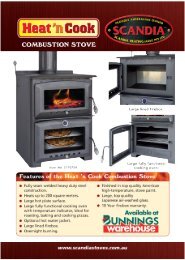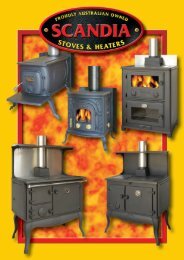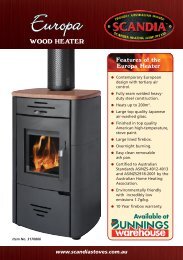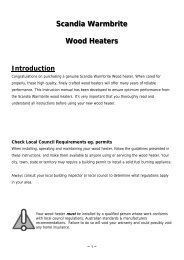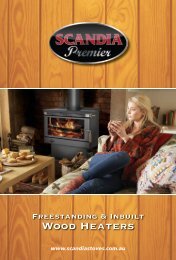Scandia Premier Wood Heaters - Scandia Stoves & Spares
Scandia Premier Wood Heaters - Scandia Stoves & Spares
Scandia Premier Wood Heaters - Scandia Stoves & Spares
You also want an ePaper? Increase the reach of your titles
YUMPU automatically turns print PDFs into web optimized ePapers that Google loves.
Operating Your <strong>Wood</strong> Heater<br />
Fuel<br />
Your wood heater is designed to burn dry hardwood only.; it is not designed to burn,<br />
� Soft wood<br />
� Paper or cardboard, other than small amounts used to light stove.<br />
� Treated or painted wood<br />
� Synthetic fuel or logs that are not approved for solid fuel stoves<br />
� Household rubbish<br />
� Liquid fuels<br />
� Plastics<br />
Burning these or other products for which the wood heater was not designed may damage the<br />
wood heater and cause a fire hazard or release toxic fumes.<br />
Fuel should be stored in a dry place; wood should be dried for at least 1 year. Wet wood may<br />
cause serious creosote, which may damage your flue system and even your wood heater.<br />
Therefore the use of wet wood is strongly discouraged.<br />
First operation of stove<br />
You should begin using your wood heater by lighting small fires which get progressively bigger.<br />
We recommend a series of about 5 small fires before you put the wood heater into full service.<br />
Allow the wood heater to fully cool between each of these fires. There may be some smell and a<br />
small amount of smoke from the wood heater during the initial operations. This is perfectly<br />
normal and is merely the curing of the wood heater paint. Opening a window or door to provide<br />
additional ventilation will help alleviate this.<br />
Air controls<br />
Your wood heater needs air to burn the fuel. This air is supplied through a primary air slide at<br />
the right side of the front of your wood heater above the door. On the SCP200FS and SCP300FS<br />
secondary air is drawn into the top rear of the firebox which is not adjustable.<br />
Primary air, as the name suggests, is used for the initial burning of the fuel. Secondary air is<br />
used for secondary combustion, which makes the stove more efficient, reduces the emissions<br />
and is also used to keep the stove glass clean. <strong>Wood</strong> burns better with the air over the fire bed<br />
and when burning a lot of wood, you should use the secondary air supply more.<br />
The settings of the primary air control very much depends on draught and local conditions and<br />
after a few fires, you should have a good idea of the best settings for your stove. The air slide<br />
control should be fully opened when lighting the fire. Once the fire is established, the air slide<br />
control may be adjusted as required. Reducing the air intake will cause the wood heater to burn<br />
slower. This may cause some blackening of the stove glass, but this should burn off once the<br />
wood heater is burning brightly again.<br />
~ 8 ~



